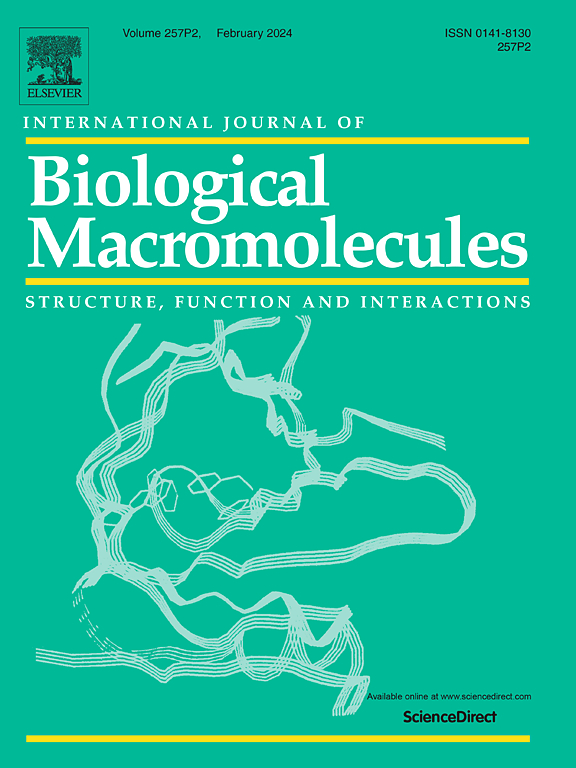来自 Parabacteroides distasonis 的新型冷活性 β-木糖苷酶及其协同水解榉木木聚糖的特性。
IF 7.7
1区 化学
Q1 BIOCHEMISTRY & MOLECULAR BIOLOGY
International Journal of Biological Macromolecules
Pub Date : 2024-11-19
DOI:10.1016/j.ijbiomac.2024.137895
引用次数: 0
摘要
虽然β-木糖苷酶在食品和医药等领域有着广泛的应用,但有关冷活性β-木糖苷酶的研究却很有限。本研究克隆了一种新型冷活性β-木糖苷酶XYL13。纯化的 XYL13 在 40 ℃ 时活性最高,在 4 ℃ 和 0 ℃ 时的最大活性分别为 42% 和 25%。同时,XYL13 主要产生 X1,同时降解 X2-X6。此外,XYL13 与内切木聚糖酶在低温下降解榉木木聚糖时有显著的协同效应(18.5 倍)。此外,定点突变试验表明,Ile269 和 Glu621 是 XYL13 的重要催化位点。最后,分子对接显示 XYL13 与 X2-X6 有很好的结合效果,验证了 XYL13 能有效切割 X2-X6 生成木糖。这些结果凸显了来自 P. distasonis 的冷适应 XYL13 在食品工业中的应用潜力。本文章由计算机程序翻译,如有差异,请以英文原文为准。
Characterization of a novel cold-active β-Xylosidase from Parabacteroides distasonis and its synergistic hydrolysis of beechwood xylan
Although β-xylosidases have broad applications in fields such as food and medicine, there is limited research on cold-active β-xylosidases. This study cloned a novel cold-active β-xylosidase XYL13 from Parabacteroides distasonis. The purified XYL13 exhibited the highest activity at 40 °C, with 42 % and 25 % of its maximum activity at 4 °C and 0 °C, respectively. Meanwhile, XYL13 predominantly produces X1 while degrading X2-X6. Additionally, XYL13 showed a significant synergistic effect (18.5-fold) with endo-xylanase for degrading beechwood xylan at low temperatures. Moreover, the site-directed mutagenesis assay indicated that Ile269 and Glu621 are essential catalytic sites of XYL13. Finally, molecular docking showed that XYL13 has an excellent binding effect with X2-X6, verifying that XYL13 can effectively cut X2-X6 to produce xylose. These results highlight the potential of cold-adapted XYL13 from P. distasonis for application in the food industry.
求助全文
通过发布文献求助,成功后即可免费获取论文全文。
去求助
来源期刊
CiteScore
13.70
自引率
9.80%
发文量
2728
审稿时长
64 days
期刊介绍:
The International Journal of Biological Macromolecules is a well-established international journal dedicated to research on the chemical and biological aspects of natural macromolecules. Focusing on proteins, macromolecular carbohydrates, glycoproteins, proteoglycans, lignins, biological poly-acids, and nucleic acids, the journal presents the latest findings in molecular structure, properties, biological activities, interactions, modifications, and functional properties. Papers must offer new and novel insights, encompassing related model systems, structural conformational studies, theoretical developments, and analytical techniques. Each paper is required to primarily focus on at least one named biological macromolecule, reflected in the title, abstract, and text.

 求助内容:
求助内容: 应助结果提醒方式:
应助结果提醒方式:


